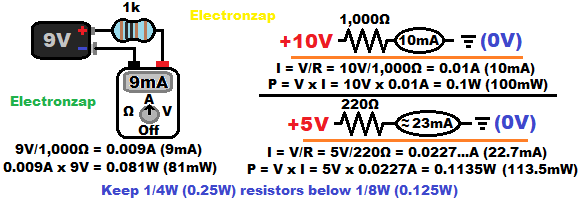Table of Contents
The amount of current a resistor passes is based on the voltage across it. The amount of voltage in volts, is divided by the resistance in Ohms. That gives you the current in Amps.

Symbols for formula calculations.
- I = Current
- Unit: Amp (A)
- V = Voltage
- Unit: Volt (V)
- R = resistance.
- Unit: Ohm (Ω)
Really nice looking resistor kit for those beginning studying electronics. Affiliate link ad.
Ohms law formula for current: I=V/R
Current in (Amps) through a resistor, is the voltage across it (in volts), divided by it’s resistance (in ohms). I = V/R
Some other examples.
- 100 ohm resistor with 1V across it will pass 1V/100Ω = 0.01A. Which is 10mA.
- That will produce 1V x 0.01A = 0.01W of power.
- 100 ohm resistor with 3V across it will pass 3V/100Ω = 0.03A. Which is 30mA.
- That will produce 3V x 0.03A = 0.09W of power.
Most resistors are rated to dissipate 1/4W (0.25W) maximum. However, it is still recommended to keep the wattage of a 1/4W resistor below half of that. So, below 1/8W (0.125W).
Video:
To support this site, check out the following links:
- Become a Patron!
- Check out my YouTube videos! https://www.youtube.com/c/Electronzap/videos
- Products I used in my videos or otherwise think look like a good buy. As an Amazon associate, I earn from qualifying purchases. https://www.amazon.com/shop/electronzapdotcom
- Information on this site is not guaranteed to be accurate. Always consult the manufacturer info/datasheet of parts you use. Research the proper safety precautions for everything you do.
- Electronzap is a participant in the Amazon Services LLC Associates Program, an affiliate advertising program designed to provide a means for sites to earn advertising fees by advertising and linking to amazon.com.